The Mystery And Origins Of Olmec Giant Stone Heads
The Oldest Civilization of Meso America

Olmec culture is considered a mother civilization in Mexican regions and by most specialists. Being the oldest of Mesoamerica, it had a decisive influence on all the peoples of the region who succeeded it: Mayas, Zapotecs, Toltecs, Aztecs. The olmec civilization left spectacular traces of its passage on earth such as gigantic head sculptures carved into stones whose vocation remains a mystery. Many experts commented on their manufacturing method, their aesthetics as well as their size.
Olmec history
In the Gulf of Mexico, the province of Vera Cruz is well known for its oil fields. If this region has many tar ponds, it is also a place where you can discover the remains and artifacts of an ancient civilization that remained in the shadows for a long time. Indeed, the two largest peoples of the pre-Columbian history of Mexico, the Mayans and the Aztecs, have for decades veiled the achievements of other cultures of Mesoamerica.
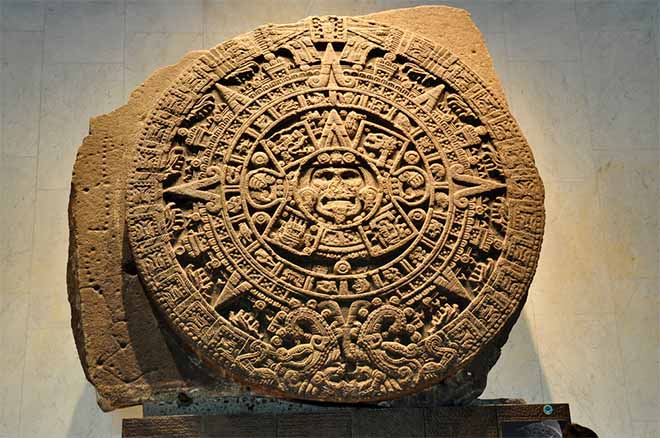
The Spaniards, knowing the Mayans and the Aztecs for having fought against them during conflicts making them masters of the country, have regularly described these local and pagan cultures. Until the 19th century, olmec culture was very rarely spoken of. Archaeological finds are often equated with the Mayans, yet they do not recognize the specific character of olmec civilization. For lack of knowing by what name they called themselves, we later called them "Olmecs", a term corresponding to the Aztec version of the word "rubber". The Olmecs began to intrigue researchers when the first colossal head attributed to them was discovered in the municipality of Tres Zapotes. The stupefaction following the first discoveries quickly gave way to suppositions of all kinds. The particular style of the sculpture as well as the features of the face which evoke nothing familiar seem, a priori, to be local. The olmec head is dressed in a kind of helmet or cap that gives it a warrior look. In addition, its fleshy coarse features, thick lips and flat nose suggest that it may be of sub-Saharan origin.
Olmec origins
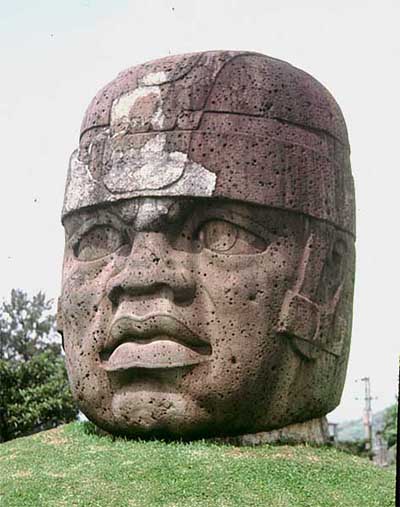
Christopher Columbus can no longer be described as "the discoverer of America". The ancestors of the indigenous, Paleo-Americans from Asia and perhaps even from Europe and Africa are the true discoverers of the New World. It can be said with certainty that Europeans, especially the Vikings, knew America well before Christopher Columbus. It is easy to imagine that during the Olmec era, Egyptians, Phoenicians or West Africans might have found themselves lost at sea before being pushed along the trade winds to finally be shipwrecked on US shores. Certain pre-Colombian artistic representations do indeed evoke european or negroid facies. It is argued that if the Olmecs were able to build pyramids, it is probably because another civilization such as the Egyptians or Atlanteans transmitted their knowledge.
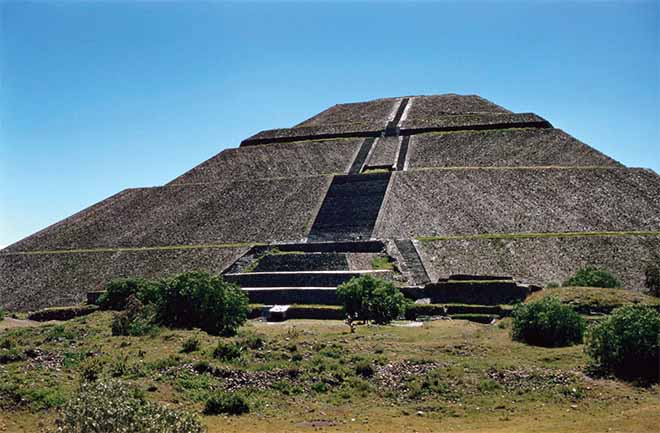
It is considered from the outset that olmec heads are of African origin. However, this thesis is currently supported neither by archeology, nor by sources, nor by anthropological observations. Olmec people are passionate about their mysteries and their artistic skill and it is with astonishment that it was discovered in the middle of the 20th century that their sculptures are older than those of the Mayans. Using carbon 14 dating technique, it has been confirmed that the olmec civilization constitute the oldest culture of Mesoamerica, which was at first only a simple hypothesis. All the civilizations that followed were inspired by the Olmecs. Among other things, there is the knowledge acquired by olmec culture about the invention of writing, the calendar, the construction of the first American pyramids, numerous artistic codes and the bases of all their beliefs and religion. The Olmec period spans 700 years, from 1200 BC to 500 BC. The Olmecs were followed by the Mayans and then the Aztecs, 1500 years later. The Olmecs were able to grow as much because of better food production capabilities, especially their advanced knowledge of agriculture. This engendered a demographic expansion and a phenomenon of institutionalization of religion, emergence of aesthetic code and all that is attributed to the identity of the olmec culture.
The Olmec Mystery
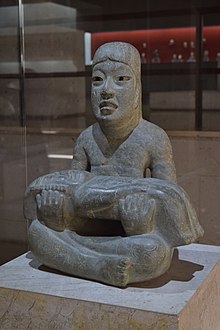
One of the big problems when trying to analyze ancient cultures is that there are very few sources of information. The writing appeared in Mesoamerica with the Cascajal Block, around 900 BC. This stone, discovered in Mexico in 1999, has 62 hieroglyphs and is the oldest writing in America. But of all the available scriptural sources, there is nothing to shed light on the Olmec mystery. In addition, the tropical climate specific to their geographical area does not help the conservation of artifacts and bodies. Of all the primordial foci of civilization throughout the world, the Olmecs are the only ones to have developed from a humid tropical context. Finally, the high degree of organization they have reached in this part of the world knows no equivalent with whom exchanges could have been possible and which could possibly have left a description of the Olmec way of life. Current knowledge is still too recent and incomplete to be able to draw a precise portrait of this civilization. Olmec language, olmec religion and rituals as well as olmec physical type are all mysteries that remain to be solved.
Olmec jaguar
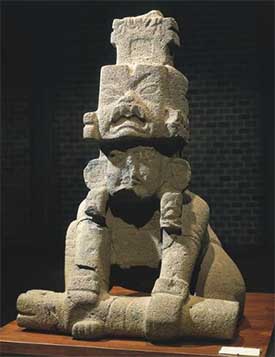
When it comes time to analyze the Olmecs, deductions and suppositions are masters. Some things are however unequivocal. For example, the jaguar was a revered animal and played a very special worship role in olmec religion. Moreover, certain aspects of human representations have a hybrid appearance and take on feline characteristics: rolled up lips, down grimace of the mouth, almond folding of the eyes ... These are all features that make you think of a jaguar. In addition, the Olmecs have a reputation for their "baby" style sculptures. It is common to notice babies with feline traits, which demonstrates once again the importance given to this wild animal in olmec religion. This suggests that olmec people believed in a form of filiation between the jaguar and men. However, what baffles most the experts are the giant olmec stone heads discovered on the large sites of Tres Zapotes, San Lorenzo and Venta. Despite the age of these sculptures, they are considered among the finest in Mesoamerica. Some have a particular aesthetic evoking Africa while others have the appearance of the current populations of the province of Veracruz. Flat and broad nose, round faces and fleshy lips are typical features of olmec heads.
Olmec heads
Olmec sculptures are always bodyless and even if a standard style emerges of all olmec statues, each head is personalized and evokes a specific individual. Of the 17 olmec heads found, they all seem distinguished. Olmec heads measure between 1.50 meters and 3.50 meters and weigh several tons. The largest olmec statue weighs about fifty tons. These huge heads, cut in basalt, were made at a place of extraction before being transported to the place of their installation. One always wonders how such an ancient people ignorant of metallurgy could have produced such objects and transported them through the jungle. Having no hammer or chisel, olmec sculptors had no other choice but to use pebbles to extract, rough and finally carve heads.
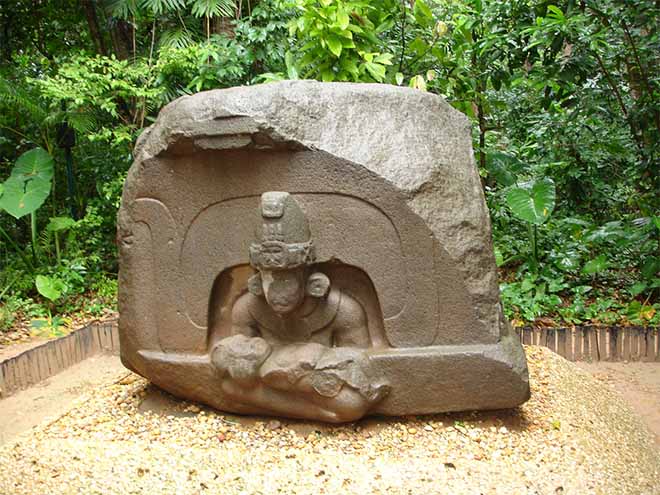
The raw material comes from partially or completely detached blocks of the basaltic veins in the region of La Cobata. Aided by their pebbles, workers would directly strike a chosen block in order to rough it off. Then two stones are used to carry out the finishing work. One serves as a hammer while the other serves as a striker. The round appearance of olmec heads is obtained by rubbing the surface with hard stones, which gives beautiful regular curves. Some statues are also richly decorated. The place of extraction of the rock is located at 150 km on average of the place where the sculptures are definitively installed. How could they move blocks of a few dozen tons through the rainforest, without knowing the wheel and without animal traction? Several detours are necessary to circumvent the too wooded, too soggy regions ... It is also necessary to avoid this region heavy rain seasons as well as frequent floods. The current theory is that olmec people knew boats and that they were able to travel by sea across the country.
A representation of the elite ?
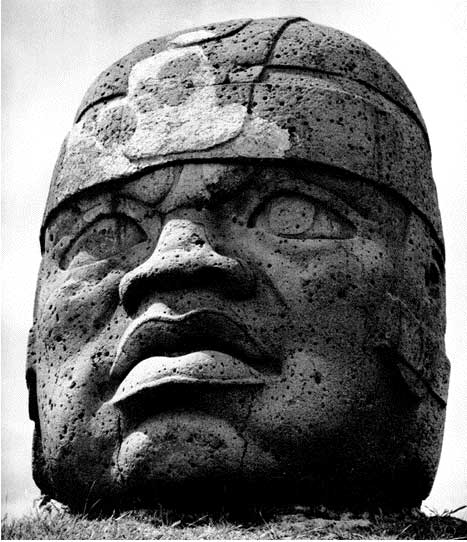
In order to be able to mobilize the necessary resources for the accomplishment of such a monumental project, one must enjoy a certain authority. It is from this observation that one can assume that olmec heads probably represent the elite of olmec political and social life. As olmec statues are all unique, it is possible that they correspond to real individuals with their own characteristics. It is also possible that these bodyless heads are a representation of decapitated ball players. Indeed, the pre-Columbian ball games often ended with the beheading of the losers. These monuments would do honor to these high-level athletes who died in the service of their gods and beliefs ...









































































































































































































































































































































